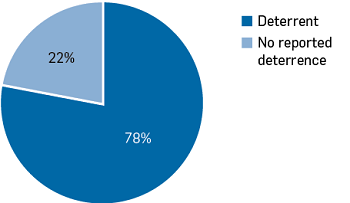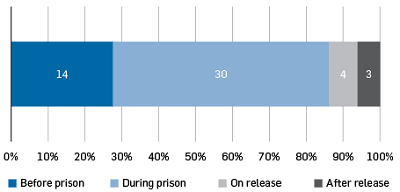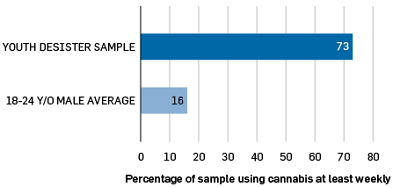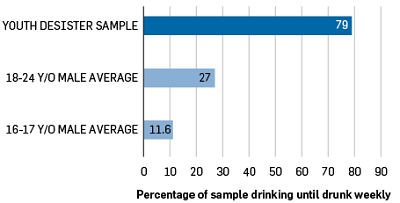Lessons from research into youth desistance
Jill Bowman
Principal Research Adviser, Department of Corrections
Author biography:
Jill joined the Department of Corrections’ Research and Analysis Team in 2010. She manages a variety of research and evaluation projects, and has a particular interest in desistance, how probation officers work with offenders, and the needs of female offenders. As well as working for Corrections, she volunteers at Arohata Prison, teaching quilting to the women in the Drug Treatment Unit.
Introduction
A person who starts offending at a young age and who receives a prison sentence before turning 18, is likely to continue committing crime regularly and for many years. Young offenders have higher reconviction and re- imprisonment rates than older offenders. In a five-year follow-up to June 2014, 91 percent of those under 20 were reconvicted and 65 percent were re-imprisoned. As a result, offenders imprisoned as teenagers tend to accrue some of the highest total Corrections costs over the course of their offending.
An understanding of why some offenders who start committing crime at an early age do not go on to become persistent offenders can provide useful insights into the support and resources that may encourage young offenders to turn their lives around. Appropriate interventions by Corrections and other agencies have the potential to reduce significantly re-offending by young people.
The research was thus intended as a qualitative survey of a relatively small sample of offenders to see whether we could obtain understanding of ‘what helps’ when offenders decide to give up crime. The purpose was purely practical in the sense of generating insights that could be used to improve our case management, one-to-one work, or rehabilitation programme content, that would leverage off these insights. The research was not designed to be an in-depth and carefully controlled study of the nature and processes involved in general offender desistance. For this reason methodological design features, such as a comparison ‘persisters’ group, were not utilised.
How the research was done
The Department identified nearly 450 offenders from its files who:
- had completed at least one prison sentence between 1 January 2000 and 31 December 2009
- were aged 20 or under when they completed that prison sentence
- were assessed at the time of their last prison release as having a RoC*RoI risk score greater than 0.5 (that is, a greater than 50 percent likelihood of being re-imprisoned within five years of release)
- had not received a community-based or prison sentence in the three years since 1 January 2010.
After confirming these individuals met the criteria for inclusion in the research, an attempt was made to find recent contact details for them. This was done through searches of our own records on our Integrated Offender Management System (IOMS) database, social media sites, White Pages, and electoral rolls. We also arranged for Immigration New Zealand to match these names with their records to identify anyone who had left the country. Efforts were also made through public sources to exclude those who had died. Eliminating those who had emigrated or died, or who otherwise did not meet the criteria, left almost 300 names.
Following a competitive tender, the Department contracted Dr Jarrod Gilbert, Independent Research Solutions, to interview 50 offenders from the 300 remaining names. We provided him with the names, dates of birth, and the most recent contact information we had been able to ascertain about the former offenders. Dr Gilbert employed a private investigator to track down the large numbers of people whose contact details were no longer current. In many cases the contact information was for a family member or friend of the offender, requiring that person to pass on a request for an interview to the individual.
Dr Gilbert was able to interview 51 former offenders from throughout New Zealand, comprising 49 males and two females. Thirty-two (63 percent) identified as New Zealand European, 13 (25 percent) as Mäori, four (eight percent) as Asian and two (four percent) as Pacific Peoples. This compares with the potential sample pool of 44 percent New Zealand European, 45 percent Mäori, seven percent Pacific Peoples and 12 percent Other. At the time of interview, the participants were aged between 23 and 34 years, with an average age of 28.7 years.
Twenty-six of the interviews were conducted face-to- face and the remainder were conducted by telephone. Dr Gilbert conducted all interviews, which ensured consistency of approach.
From the literature review conducted by the Department, topics relevant to a discussion of desistance were identified. From this, Dr Gilbert designed a semi-structured interview schedule. Areas explored covered the offender’s background, including family, relationships, community, school, employment, health, and drugs and alcohol. The person’s offending history covered their entry into crime, co-offenders, the nature of their offending and their attitudes towards crime at that time. Prison experiences covered the offender’s attitudes towards prison before, during and after their imprisonment, and programmes or other support they received while in prison. Circumstances following release covered support in the community, education, employment, relationships – including partners and children, contact with probation, and programmes. Importantly, participants were asked questions about their desistance from crime including what motivated their decision.
Key findings
Imprisonment
The factor that study group members most commonly reported as significant in initiating desistance was the experience of having been imprisoned. Forty of the 51 people interviewed stated that being sent to prison was central to making a conscious and deliberate decision to cease further involvement in crime.
Prison as a deterrent
 In elaborating on what it was about imprisonment that made it so ‘influential’, many spoke of being afraid of what could happen to them in prison, such as the risk of being assaulted by other prisoners. Others spoke of a sense that they “didn’t belong in there”, that they “weren’t like the other prisoners”. A few described as exceedingly unpleasant the thought that they could end up like the “old laggers,” prisoners whose lives appeared to consist of little other than recurrent jail time. For some, the most pervasive aspect was the extreme boredom and tedium; a few cited the loss of freedom as particularly painful.
In elaborating on what it was about imprisonment that made it so ‘influential’, many spoke of being afraid of what could happen to them in prison, such as the risk of being assaulted by other prisoners. Others spoke of a sense that they “didn’t belong in there”, that they “weren’t like the other prisoners”. A few described as exceedingly unpleasant the thought that they could end up like the “old laggers,” prisoners whose lives appeared to consist of little other than recurrent jail time. For some, the most pervasive aspect was the extreme boredom and tedium; a few cited the loss of freedom as particularly painful.
Guilt and shame over embarrassing or disappointing their families by going to prison was mentioned by 29 of the participants. This was particularly noted in relation to their mothers, and was a significant influence on deciding to change their life course.
Study participants who had spent time in both youth and adult units reported that the youth units were more threatening than adult units. None of the interviewees reported having actually been assaulted while in prison, but recalled fears about personal safety being more acute when held exclusively with other young prisoners.
For those who identified prison as a key factor in deciding to desist, 27 percent made the decision prior to arriving at prison (usually at the time of arrest), 59 percent while in prison (often “on the first night”), and the remainder made the decision some time after release. This was generally described as a conscious and determined resolution. For a few, decisions were made over a longer time frame, and gradually strengthened.
Time of decision to desist
 Two thirds of the cohort (65 percent) considered that, in hindsight, prison had been a positive experience, opening their eyes to the downsides and risks of continuing in a pattern of criminality. No obvious relationship was found between the decision to desist because of imprisonment, and the length of the prison sentences imposed.
Two thirds of the cohort (65 percent) considered that, in hindsight, prison had been a positive experience, opening their eyes to the downsides and risks of continuing in a pattern of criminality. No obvious relationship was found between the decision to desist because of imprisonment, and the length of the prison sentences imposed.
Personal agency
Also found to be important in motivating desistance was an emerging belief in participants that they could, if they so chose, turn their lives around. This was associated with a sense of accepting responsibility for offending, even when others (co-offenders) were involved. Most were motivated by a desire to “move away” from an offending lifestyle rather than a sense of wanting to “move towards” a different (non-offending) lifestyle. While almost half of the cohort recalled having plans for the future at the time of desisting, plans tended to be basic and often vague, mainly revolving around simple lifestyle changes such as “giving up drugs and alcohol” and ceasing to associate with criminally-orientated friends.
Few of the participants reported feeling guilt or empathy in relation to their victims at the time of their offending but, by the time of interview, many recognised the harm their offences had caused. For a few, acknowledging the harms caused to others was associated with the decision to cease crime.
Programmes
Over half the cohort reported having participated in some form of correctional programme. In most cases this was while in prison, but some did so after release or while on community sentences. Recollections of programme names and content was often vague, but some mentioned group-based drug and alcohol programmes, offending-focused programmes, education, employment skills training, cultural courses and “counselling” (probably individual work with a psychologist). Sixty-nine percent of those who completed a programme reported that it had been of some benefit to them, mainly in reinforcing their decision to desist. Specific benefits included helping to overcome their addiction, developing work skills, “building confidence” and acquiring better “skills for life”.
Importantly, those who participated in programmes and courses tended to identify the person who facilitated the programme or course as the most significant influence. Particularly valued was a facilitator with whom the participant felt they could establish a good working relationship during the programme.
Probation
Eighty-two percent of participants reported having been under the supervision of a probation officer at some time, and more than half of these rated their relationship with the probation officer as either “good” or “very good”. Around a quarter specifically reported some positive benefits, including personal support, receiving practical help, and other influences which maintained their decision to desist. However, whereas some recalled a probation officer who seemed interested in helping them, a number indicated that their probation officer seemed simply to be “going through the motions”.
Support after prison
The value of social support from family and friends around the time of release was mentioned repeatedly as an important factor in helping participants “go straight”. It is a significant research finding that almost all those interviewed reported that family or friends were available to help them immediately after they were released from prison. Most moved in with a family member during this period, and the stability and assistance obtained was felt to be critically important in helping to either cement their decision to desist, or to enable them to avoid falling back into old patterns of behaviour. As well as providing needed accommodation, family (or, in some cases, others) supported them to distance themselves from pro-criminal associates, as well as providing emotional support and (occasionally also) assistance to find employment.
Alcohol and drug use
Heavy use of alcohol and drugs was a major factor identified by many in the cohort in precipitating or maintaining their offending. Almost 80 percent reported using marijuana at this time, with some also using harder drugs. A similarly high proportion reported getting drunk regularly. Based on Ministry of Health data, the cohort’s drug and alcohol use was significantly higher than that of a similar demographic.
Using cannabis at least weekly pre-prison

Drinking enough to feel drunk at least weekly – pre-prison

Source: Ministry of Health (2010)
Most reported that, at the time, they did not consider their alcohol or drug use to be a problem. Now, in retrospect, their alcohol and drug use was generally regarded as highly problematic. Most of these participants reported a significant decrease in drug and alcohol use since ceasing their offending. Interestingly, however, reported levels of both cannabis use and alcohol consumption remained significantly above population norms.
Though most had significantly reduced their drug and alcohol use, only a minority considered that this was important to their on-going desistance. Instead, reduced levels of use/consumption were regarded more as a consequence of having altered their lifestyles.
Some spoke of a sense of having matured and that, having taken on responsibilities (such as new partners, children or steady employment), it simply wasn’t feasible to continue on as before.
Changing peer groups
Conscious decisions to change patterns of peer group involvement emerged as an important factor in “giving up crime”, and was reported by most of the participants. Strong links with other offenders tended to be the norm when the participants were actively offending. It was seen as “obvious” by almost all that these associations were a potent influence in encouraging regular offending. Consequently, almost two-thirds (63 percent) recalled having made a deliberate decision, and efforts, to sever ties with criminal associates after release from prison. Some acknowledged still having some contact with “old mates”, but this was not a primary social connection for any of them.
Employment
Almost all participants recalled wanting to find employment after their release from prison, and more than three-quarters reported finding work within three months. Sixty-one percent indicated that having a job was important in supporting their desistance from crime. Mentioned in this respect was the sense of being able to form new and pro-social friendships, and the stability of lifestyle that work created. On the other hand, the most common view was that their desistance was not dependent on finding or keeping employment. None thought that they would return to crime if they lost their employment and some reported periods of unemployment through which they had maintained
their desistance.
Partners and children
At the time of interview 59 percent of study participants were, or had been, in a serious long-term relationship, and a similar proportion had children. Most relationships were formed after release, in some cases several years later. Most of these individuals believed that these relationships and responsibilities had helped them remain crime-free. Although no conclusions should be drawn when numbers are so low, this factor was particularly salient for the two women interviewed for the research.
Conclusion
As noted, the research here was intended as a qualitative survey of a relatively small sample of offenders to see whether we could obtain further understanding of ‘what helps’ when offenders decide to give up crime. It was not designed to be an in-depth carefully controlled study of the nature and processes involved in general offender desistance, and should not be interpreted as such.
The research showed that the experience of a prison sentence was the most significant factor in the decision to desist. Deterrence was influenced by the fear of what could happen in prison, boredom, and a feeling of not being like other prisoners. Some of the participants also felt ashamed by the hurt caused to family members.
Most of the interviewees took full responsibility for their crimes, and their decision to change was a conscious one. Over a quarter had decided to desist before going to prison, usually at the time of arrest, and a further half decided to cease offending while they were in prison. Prison rehabilitation programmes provided skills to support desistance.
Support immediately after release from prison was critical in maintaining the determination to desist from crime. This was most often provided by family members. Having somewhere to stay, as well as emotional support, assisted the offenders to avoid negative peer influences and to make plans for their future. Replacing anti-social associates with pro- social friends was recognised as being crucial to changing behaviour.
Drug and alcohol use by the young offenders was significantly higher than for a comparable demographic and was identified as a major factor in precipitating or maintaining offending. Although most reported a significant decrease in their drug and alcohol use since leaving prison, it was still generally higher than for their population norm. They regarded their reduction in use as a consequence of their change in lifestyle, rather than a factor in their desistance.
Work was important in developing a stable lifestyle and providing the opportunity for new pro-social friendships, but desistance did not depend on employment. Similarly, partners and children supported the offenders’ pro-social identity, but were not instrumental in the decision to desist.
The research findings suggest several areas where the Department could strengthen its interventions for young people to improve the likelihood of their desisting from crime. The importance of reintegrative assistance, including accommodation, employment and other support is well-recognised, and additional help could be provided in this area. Ensuring young offenders are well supported on their release from prison, including reconnecting them with estranged family members, is another area that could be further enhanced. Another area with potentially high value is to consider how desisting offenders’ ‘self-talk’ might be utilised in enhancing the impact of young offenders’ rehabilitation. It may be feasible to investigate ways in which the pro- desistance reasoning of participants could be used to craft specific messaging for use by facilitators of short interventions as well as frontline staff (corrections officers and probation officers).
To receive a copy of the full research, please contact research@corrections.govt.nz

